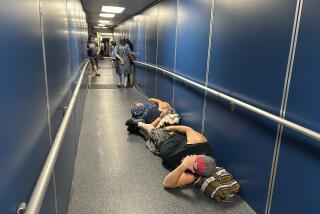Technical Glitches Prompt Nasdaq to Extend Trading
Trading on the Nasdaq Stock Market was disrupted late Friday for the second day in a row, forcing Nasdaq into the unusual position of extending its trading day by one hour.
Nasdaq prolonged trading until 2 p.m. PDT after an earlier shutdown of its two automated trading systems stranded investors on one of the busiest days of the year.
The outage rippled through exchanges and trading desks across the nation: The Chicago futures and options exchanges also extended trading hours, and the main U.S. stock market gauges kept ticking beyond their normal 1 p.m. PDT close.
A Nasdaq spokesman said he did not know whether a trading day had ever been extended before, although traders said they could not recall such an incident.
“I’ve been in this business since 1982, and I’ve never seen anything like it,” said Mark Donahoe, head of sales trading at U.S. Bancorp Piper Jaffray in Minneapolis. “It’s been a mess.”
The problem was traced to WorldCom Inc., the telecommunications giant that handles Nasdaq’s data services. WorldCom said one of its technicians caused the error during “routine” testing of Nasdaq systems.
Trading on Nasdaq’s SelectNet and SOES systems was suspended from about 11:30 a.m. to 12:51 p.m. PDT, a Nasdaq spokesman said. Traders complained that the system later failed for a second time, but the Nasdaq spokesman said he was unaware of it.
On Thursday, Nasdaq trading was interrupted for nearly 30 minutes because of technical difficulties.
Though systems outages always create headaches for traders, Friday’s was especially problematic. With the second quarter ending Friday, many professional money managers were rushing to complete transactions before the end of the day.
Trading often is heavy in the final days of a quarter as mutual funds beef up their holdings of winning stocks to embellish the quarter-end performance records that are reported to shareholders--a practice known as “window dressing.”
“It really created an incredible amount of confusion and risk,” said Andy Brooks, head trader at the T. Rowe Price mutual-fund group.
To give an idea of the amount of trading that occurs at the end of a quarter, the New York Stock Exchange had its fourth-busiest day Friday, and Nasdaq had one of its most active trading days this year.
The shutdown created extra problems for mutual-fund companies that run so-called index funds.
At the close of trading Friday, stock indexes run by Frank Russell Co., including the widely followed Russell 2,000 small-cap index, completed their annual re-balancing, which involves shifting hundreds of stocks within the indexes.
That forced funds that seek to mimic the performance of the indexes to buy shares being added to the indexes and to sell those being dropped. Nasdaq’s shutdown sent them scurrying to alternative trading networks to make their trades.
“This is probably one of the worst days for Nasdaq to go down,” said Tom Taggart, a spokesman for Barclays Global Investors, a San Francisco-based index-fund firm.
One side effect of the outage was that the closing price of the widely followed Dow Jones industrial average was delayed while Microsoft and Intel--the only Dow members listed on Nasdaq--continued trading in the extended session.
Nasdaq has drawn criticism in the past for periodic outages, some of which have been caused by heavy volume. The rival NYSE also has suffered trading glitches. This month, trading was blocked for 85 minutes one morning because of a software snafu.
*
Times staff writer Thomas S. Mulligan and Reuters contributed to this report.
More to Read
Inside the business of entertainment
The Wide Shot brings you news, analysis and insights on everything from streaming wars to production — and what it all means for the future.
You may occasionally receive promotional content from the Los Angeles Times.










